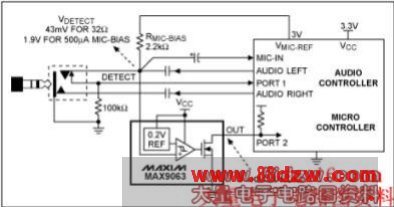Keep Power Consumption in Chec
[11-20 17:32:32] 来源:http://www.88dzw.com 模拟电子技术 阅读:8997次
文章摘要:To detect the type of headset connected, refer to Figure 4. Here a 2.2kΩ RMIC-BIAS resistor connects to a low-noise reference voltage from the audio controller (VMIC-REF). When an audio jack is inserted, this VMIC-REF voltage is applied through RMIC-BIAS to the tip-to-ground resistance (not shown),
Keep Power Consumption in Chec,标签:模拟电子技术基础,模拟电子电路,http://www.88dzw.comTo detect the type of headset connected, refer to Figure 4. Here a 2.2kΩ RMIC-BIAS resistor connects to a low-noise reference voltage from the audio controller (VMIC-REF). When an audio jack is inserted, this VMIC-REF voltage is applied through RMIC-BIAS to the tip-to-ground resistance (not shown), thus producing the voltage VDETECT at the noninverting input of the . This resistance can be small for stereo headphones (8Ω, 16Ω, or 32Ω), or high due to the microphone's constant-current sink which ranges from 100µA to about 800µA according to the type of microphone. Because VDETECT varies with the model of headset plugged in, the headset type is detected by monitoring VDETECT with a comparator.

Figure 4. A comparator circuit used for headset detection.
Assuming that the microcontroller's reference voltage (VMIC-REF) is 3V as shown, a 32Ω headphone load produces 43mV at VDETECT. A constant 500µA microphone load, however, produces 1.9V. Note that a direct interface for VDETECT can be challenging in most practical cases. Assuming that the CMOS inputs of a typical microcontroller port demand logic levels above 0.7 × VCC and below 0.3 × VCC, then the input logic for a controller operating with a 3.3V supply should be above 2.3V and below 1V.
A 1.9V level generated by a 500µA microphone load does not qualify as a valid logic 1. Microphone bias currents from 100µA to 800µA generate VDETECT levels from 2.78V to 1.24V, and any voltage below 2.3V violates the controller's VIH specification (input high level, assuming 2.2kΩ for RBIAS). To get 2.3V or above, the microphone bias current must be 318µA or less. Otherwise you must change the 2.2kΩ bias-resistor value which, in turn, changes the sensitivity point of the microphone. Generating a logic low of 1V and below is easy, because headphones with typical 32Ω loads can easily pull the level close to ground.
To detect the type of headset connected, you therefore feed VDETECT to one input of a comparator and a reference voltage to the other input. The comparator's output state then represents the type of headset.
The comparator for this portable headset-detect application should be tiny and consume little power. The comparator in Figure 4 is just 1mm × 1mm and draws a maximum supply current of only 1µA. Its strong immunity to cell-phone frequencies provides highly reliable operation. The comparator also has internal hysteresis and low-input bias currents. These features make it an excellent choice for headset detection in battery-operated, space- and power-sensitive applications like cell phones, portable media players, and notebook computers.
Hook-Switch Detection
Most hands-free headsets include a switch, usually known as a hook switch, that accepts and ends calls; provides the MUTE/HOLD function; and holds an ongoing call while receiving a second call. The microcontroller controlling the headset needs to detect the status of the hook switch and the presence of the headset. The jack (hence the headset) can be detected automatically (Figure 1). A signal for the hook-switch status can also be generated. Status-detection circuitry for the hook switch comprises a 4-connecter stereo headset with microphone and a parallel hook switch (Figure 5
Tag:模拟电子技术,模拟电子技术基础,模拟电子电路,模拟电子技术
- 上一篇:音频DAC的工作原理
《Keep Power Consumption in Chec》相关文章
- › Keep Power Consumption in Chec
- 在百度中搜索相关文章:Keep Power Consumption in Chec
- 在谷歌中搜索相关文章:Keep Power Consumption in Chec
- 在soso中搜索相关文章:Keep Power Consumption in Chec
- 在搜狗中搜索相关文章:Keep Power Consumption in Chec
分类导航
最新更新




 当前位置:
当前位置: